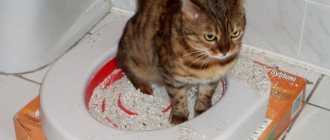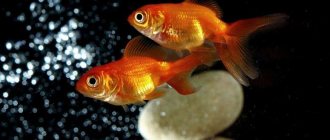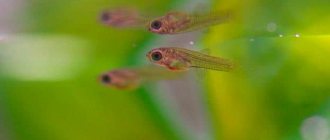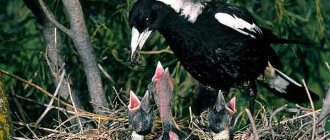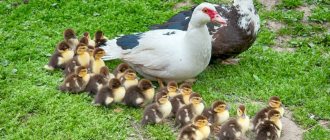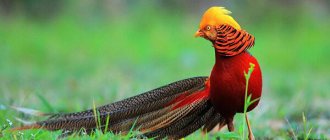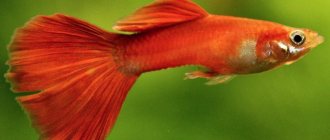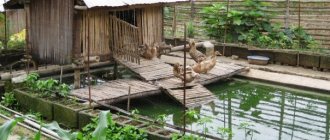337
no comments yet
0
Author:
Rasskazov Pavel.
Reading time: 19 minutes
There are several reasons why you can raise pheasants at home:
- for hunting purposes, releasing mature birds into the wild on hunting grounds;
- to obtain delicious meat and eggs that are in demand in the restaurant business;
- for decorative purposes, for participation in exhibitions.
The lack of much competition, the high price of meat and the uniqueness of the pheasant farm as such are the main reasons that encourage you to take up this interesting business.
Description of pheasant
Pheasants, despite the variety of breeds, have similar features by which they can be unmistakably identified. These chicken-like birds are quite large and have a bright, memorable appearance. Among their main signs:
- Gracefulness.
- Males have beautiful plumage.
Females cannot compete with males in terms of decorativeness. Only males are endowed with bright, colorful feathers. Females have gray plumage, their only “decoration” is black and brown specks, generously scattered throughout the body.
The coloring of males of different breeds is different and depends on their habitat. But, as a rule, all breeds have a green or blue-violet head and neck. Around the eyes there are rings without feathers. Usually the rings are red, but they can have other colors. The color of the plumage depends on the breed of pheasant. Males are lavishly colored; nature has given them the brightest colors - orange, blue, bright red, emerald.
The length of the male is about 80 cm, the female is slightly smaller. Any breed of pheasant can be bred for meat, but preference is given to heavier birds. The choice is made taking into account meat and egg productivity.
Breeding Features
Pheasants are bred by both industrial and private household farms. With the industrial method of cultivation, the emphasis is on accelerated weight gain and increasing the number of livestock. Farms contain up to 10,000 birds. Small farms are focused on meeting their own needs and making a profit from the sale of products.
To start a pheasant breeding business, you will need to buy several families, which, as they multiply, increase the number of livestock. Beginning farmers are recommended to start with silverwood - it grows better than others in a temperate climate.
Why is it profitable to breed pheasants:
- unpretentious when it comes to nutrition;
- gain weight quickly;
- bring real profit to their breeders - from the sale of meat, eggs and feathers.
To breed pheasants on their own, they are placed in families - there should be 2-3 females per male. You can also use other schemes - for 1 male there are from 4 to 7 females. But you should remember - the more females there are per male, the lower the egg production and the fewer fertilized eggs.
The main feature of breeding pheasants is that they cannot be kept in closed cages; this bird needs spacious enclosures covered with mesh.
Females with high egg production lay about 50 eggs per season. But if desired, this figure can be increased to 100 eggs. To do this, laying hens are given:
- Biovit – 0.7 g.
- Terramix-10 – 1.1 g.
- Penicillin sodium salt – 0.3 g.
- Erythromycin – 21.5 g.
- Biomycin – 35-40%.
In the video below, a pheasant breeder shares his knowledge of raising pheasants at home:
Useful tips
Experienced poultry farmers rarely share the secrets of successfully raising domestic pheasants with novice farmers, but some secrets were still revealed:
- To build an enclosure, choose a dry, flat area, protected from strong winds.
- There should not be many objects on the territory of the poultry house, otherwise the domestic pheasants will feel uncomfortable and cramped.
- The owner should regularly clean the poultry house, wash feeders and drinkers.
- You cannot keep two adult males in one enclosure, otherwise the birds will fight.
- Sometimes the feathers of domestic pheasants break, in which case they should be pulled out. The bird will not be hurt, and a new feather will grow in place of the old one.
- Patients are regularly examined and their behavior and appetite are monitored in order to notice an impending illness in time.
- Eggs and chicks are purchased only from trusted farmers.
- Pheasants are shy birds. At the slightest danger or loud sound, they try to fly away. The pen or enclosure should be covered with soft netting to prevent the pheasants from escaping and being injured when attempting to escape. The second option is a structure with high walls that converge towards the center.
Breeding domestic pheasants, with proper management and attentive approach of the owner, will become a successful business that brings in a constant income. However, keeping these birds has difficulties and nuances that the farmer should take into account, so it is better for beginners to start not with large-scale purchases, but with the purchase of a couple of domestic pheasants.
Important aspects of buying poultry
To start a pheasant farm, you can use one of three ways to acquire livestock:
- Catch pheasants in the wild.
- Buy eggs for incubation.
- Buy young or adult birds from a nursery or breeder.
Wild birds are hardy and unpretentious, but they often refuse to breed in captivity. Therefore, a more reliable way is to buy a family or young animals.
Buying eggs
Buying pheasants requires a considerable investment; if finances are tight, start with eggs. This option will be much cheaper. But in order to start a business from an egg, you will need incubators or brood hens. In order for small pheasants to hatch safely, you must have at least minimal experience in breeding birds. And most importantly, in order to get offspring from eggs, you should:
- Transport eggs carefully, avoiding any shaking.
- Prevent temperature changes.
The cost of one hatching egg is 80-110 rubles.
Purchase of chicks
The most productive option for opening your own mini-farm for breeding pheasants is to purchase young animals. You should not take chicks that are too small. The best option is individuals aged 4-5 weeks. Characteristics of healthy young animals:
- active behavior, mobility;
- the food search reflex is well developed;
- good spatial orientation;
- dry, withered umbilical cord;
- absence of growths on the beak and nostrils.
Pheasants have no visible sex differences until they are 3-4 months old.
Prices for young animals:
- One pheasant chick, up to 3 months old, costs 200-300 rubles.
- Individuals aged 3-6 months cost 450-600 rubles.
Adults
When purchasing pheasants, you should carefully examine each individual. You need to pay attention to the following points:
- Age. It is unprofitable to take birds older than 2.5 years. After this age, pheasants' productivity declines.
- Appearance. You should not take individuals that are too thin and have excess fat deposits. To the touch, the bird should be well-fed, dense, and meaty.
- Health status. It is important to examine the feathers near the cloaca. In a healthy bird they are dry, in a sick bird they are wet and dirty.
To prevent inbreeding, it is recommended to take birds from different locations. The offspring obtained as a result of inbreeding have low immunity, and they are often infertile. To begin with, it is recommended to take 2-4 pairs, and when you develop skills in care and breeding, the number can be increased.
Chicks
As you already understand, raising pheasants from your own eggs is an excellent option. Having purchased an incubator, you will no longer need to spend money on small chicks.
However, this option is ideal only if you already have a fairly large farm. If you intend to increase it, then you will still have to buy chicks.
The best place for this is the nearby farmland where pheasants are raised. When purchasing, you will not be able to choose a male or a female, because visually they will be the same. Only after one year of life the color begins to appear, immediately after molting in the summer.
Choose visually healthy chicks, preferably larger ones. It’s good if they behave actively at the same time. Don’t be afraid of a broken feather - if you pull it out, then in half a month there will be a whole and healthy feather in its place.
Recommended Breeds
The most popular breeds of pheasants:
- Diamond pheasant. Homeland - highlands of China. It is valued for its decorativeness. This is his main advantage. This bird should not be bred for meat. Firstly, it doesn't have much meat. Meat productivity of males is 0.9-1 kg. Secondly, the diamond pheasant does not tolerate cold well - it is necessary to provide the bird with a certain temperature regime. 30-degree frosts will simply destroy this bird. Egg production – 30 eggs per season. Monogamous.
- Silver pheasant. An ideal meat breed for breeding. The silver pheasant, like the diamond pheasant, comes from China, but has perfectly adapted to the Russian climate. Thick plumage helps withstand frost. Weight – 2-6 kg. Egg production – 50 eggs per season. To stimulate productivity and increase egg production, 5-6 eggs are left under the female in the nest. They are raised for meat, for stuffed animals - they decorate hunting houses, restaurants, etc.
- Golden pheasant. Decorative breed. It is not grown on an industrial scale. Weight – up to 1 kg. Egg production – 25 eggs. Requires an insulated poultry house.
About productivity and breeding goals
There are dozens of breeds of pheasants, but among them there are several, breeds that are especially popular among farmers and breeders are bred for meat, while others are bred for hunting or for decorative purposes. Raising pheasants at home rarely brings real profit; only a large farm can become truly profitable.
When choosing an ornamental breed for breeding, the main thing you pay attention to is the exterior of the bird, its ability to reproduce in captivity and the requirements for living conditions.
When breeding pheasants for meat, the appearance of the bird is secondary, the main thing is their meat productivity. And if the farmer is going to independently replenish the livestock, then the egg production capacity of the breed is also of great importance. The most highly productive meat breeds (weight of males compared):
- Steppe hunting - 1.7-2 kg.
- White – 2.3-2.7 kg.
- Lemon – 1.9-2.1 kg.
- Eared - 2.3-2.7 kg.
- Romanian – 2.4-2.8 kg.
Other breeds of pheasants cannot boast of high meat productivity; the weight of males is from 0.9 to 1.7 kg.
The egg production of pheasants varies from 25 to 50 eggs per season and depends on the breed. The Silver Pheasant has the highest egg production. This breed optimally combines high meat and egg productivity, which is why it tops the popularity rating among farmers.
Site selection
A pheasant farm cannot be located in any place you like. The territory must meet certain requirements:
- The site must have a slope not exceeding 30°, allowing for the drainage of melt and rainwater.
- The slope of the site should be facing south, which will allow the enclosures to be illuminated throughout the day.
- To ensure uniform illumination of enclosures, it is necessary to remove vegetation that can shade them - trees and shrubs. It is permissible to locate isolated trees that do not provide dense shade.
- If it is necessary to protect the enclosures from the winds, tree and shrub vegetation must be planted around the perimeter of the farm so that it does not cast a shadow on the enclosures.
- The soil on the territory of the pheasant farm should easily pass and drain water, ideally it should be sandy or sandy loam. If the soils are heavy, a drainage system should be installed in them to collect and drain water towards the lower side of the site.
Do you have a site for a pheasant farm?
YesNo
Content requirements
To breed pheasants, it is necessary to fulfill two main conditions for their maintenance:
- The norm of area per individual for family keeping is 2 sq. m. If the birds are kept in large groups in enclosures - 5 sq. m. m.
- Aviary. Pheasants, unlike other poultry, need an enclosure fenced on all sides, including from above, so that the birds do not fly out. Birds spend winter and summer in these enclosures; there is no need to build special winter huts for them. If, of course, the breed can withstand the low temperatures characteristic of a particular area. Otherwise, you will have to equip insulated winter huts.
When pheasants are kept for meat, they are housed in large groups. They are fed with regular chicken feed. Feeding pheasants depends on the breed - each has its own requirements for everyday food. Birds must receive enough protein and calcium, otherwise cannibalism develops among them - eating their own kind.
Keeping adult birds during the non-productive period
Peculiarities:
- The unproductive period lasts from the end to the beginning of a new laying of eggs. Includes summer, autumn and winter. During this period, pheasants molt.
- It is recommended to keep pheasants in enclosures, since they can withstand winter temperatures down to -35 ° C with sufficient food and protection from the weather from reed mats, spruce branches, slate, boards, and roofing felt. In severe frosts, hay or straw is laid under the feet of pheasants in a layer of up to 50 cm.
- It is recommended to keep females and males separately in different enclosures.
- Instead of water in winter, pheasants are given snow in open containers.
- At positive temperatures, it is recommended to install automatic drinkers and tray drinkers with running water.
- Feed is supplied in bunker feeders, which are installed under a canopy that protects them from getting wet.
- Each bird in the enclosures should have at least 5 m2. With high pugnacity of males, it is allowed to reduce the stocking density to 10 m2 per head.
- Artificial lighting is not used.
Poultry house/aviary arrangement
The pheasant farming business requires start-up costs. The first step is to set up a farm. What you need to know when preparing enclosures for pheasants:
- If birds are raised for hunting, then it is better to keep them in high cages - they must learn to fly.
- If pheasants are raised for meat, high fences are not needed.
Pheasants are very pugnacious. They often pluck each other's feathers. To preserve the feather cover, breeders order special glasses made of plastic.
Pheasants need a spacious, fully fenced enclosure. Rules for constructing enclosures:
- It should be located on the sunny side. The soil is preferable - sandy.
- At the top there is a covering made of mesh, nylon or rope.
- Inside there are stairs, snags, bushes, etc.
- Grass. If it is not there, they sow it.
- In harsh climates, a heating system and individual houses are provided - a must for heat-loving breeds.
- The back wall should be solid so that the bird feels protected and can have privacy.
- A separate place for young animals.
There are particularly aggressive breeds; they cannot be kept in large groups - they will fight. Among these breeds are king pheasants; they are kept in pairs.
Enclosures are built from metal or wood. A more modern option is polycarbonate. The polycarbonate structure is impact-resistant and dry. The size of the enclosure depends on the population and breeding prospects. The total area is calculated taking into account maintenance standards. The height of the poultry house is from 2.5 m.
To build a simple enclosure, you will need the following materials:
- galvanized mesh (mesh size no more than 1.5x5 cm);
- rope or nylon mesh;
- slate, tiles or metal sheets;
- metal or wooden beams;
- sand and cement;
- nails and staples;
- gravel and sand.
Having decided on the materials and stocked up with the necessary tools, we begin to build the enclosure:
- Remove the top layer of soil. For disinfection, sprinkle the area with slaked lime - a layer 2 cm thick.
- They prepare the foundation by digging a ditch around the perimeter. Depth – 70 cm. The timbers are placed in the ditch and filled with mortar. Drying the foundation – 2-7 days.
- They put up the frame. Install the posts.
- Stretch the mesh onto the frame.
- Stretch the roof of the enclosure.
- The floor is covered with a mixture of river sand and gravel.
- They set up driftwood, perches, and ladders. They build huts from branches, houses for rest, and put boxes with ash for dust baths.
In the video below you can see in detail the arrangement of enclosures for keeping pheasants:
Do you need an incubator?
Theoretically, there are three ways to breed pheasants. But only one is really productive - artificial incubation. Female pheasants rarely sit on eggs; if this happens, the breeder is very lucky. Of the 50 eggs laid, pheasants hatch only 10-15 eggs. You can, of course, lay eggs on turkeys, ducks or chickens, but they often crush pheasant eggs.
What you need to know about egg incubation:
- Before placing eggs in the incubator, you need to make sure that they are fertilized by illuminating them with an ovoscope.
- Incubation periods depend on the type of pheasant and are often determined experimentally.
- Reliable data is available for the Hunting (Asian) pheasant. The incubation period for this breed is 24-25 days. For Silver – 30-32 days.
Rules for incubating pheasant eggs at home:
- Before placing eggs in the incubator, they should be kept at room temperature for 5 hours.
- Warmed eggs can be placed in the machine. The temperature is set to 37.8˚C.
- After two weeks, the eggs should cool slightly. For this purpose, open the incubator door for 10-15 minutes. This procedure allows you to increase gas exchange and improve metabolic processes.
- The air humidity in the incubator should be 60-65%.
- From the 22nd day they begin to reduce the temperature and increase the humidity in the apparatus.
- By day 24, the temperature should be 37.5˚C, humidity increased to 80%.
Buildings on the site
The number and size of buildings on a home farm are determined by the number and methods of breeding and keeping pheasants. To keep adult birds, it is enough to build aviaries. If you sell hatching eggs, you need to have a warehouse with low air temperatures and refrigerators. And if a poultry farmer wants to raise young animals for sale, he needs to have premises for incubators, brooders and acclimatizers.
Hatchery
It can be located in a one-story permanent building with ceilings of 2-2.5 meters, so that it can accommodate several incubators and hatchers in height if necessary.
Requirements:
- The average temperature in the auxiliary rooms is +22...+24 °C, humidity - no more than 60%.
- Hatchery equipment should not be exposed to direct sunlight.
- The finishing of walls and floors must allow disinfection. The best option is glazed ceramic tiles and porcelain stoneware.
Brooder room
This room must be separated from the hatchery due to the need to create different temperature and humidity conditions in it. If there are a large number of young animals being raised, the easiest way is to keep them on the floor, on bedding.
Basic requirements for brooders:
- A building insulated from the outside, connected, if possible, by a warm passage to the hatchery.
- Temperature – adjustable, up to +28 °C.
- Artificial adjustable lighting based on LED lamps with the ability to support round-the-clock lighting.
- Infrared heating with lamps up to 250 W.
- Heated underfloor heating for floor maintenance.
- Planting density is up to 60 heads per 1 m2.
Poultry house for young animals with walking
Requirements for the interior of the poultry house:
- Externally insulated building.
- Lack of natural lighting inside, replacing it with adjustable artificial lighting.
- The optimal internal temperature at floor level is +23 °C.
- In the internal sections and on the paddocks, doors must be installed for the passage of the poultry farmer. Doors can be mesh in the paddocks and inside the poultry house and solid insulated in the outer walls.
- In the doors connecting the sections of the poultry house with the paddocks, intended for the passage of the poultry farmer, it is necessary to install slide gates measuring 30 x 40 cm (H x W) for the exit of young pheasants to the paddock.
- Natural ventilation of the room is carried out through manholes. Large openings can create drafts inside the house.
- Walks that are longer can be divided into sections. The sections farthest from the poultry house must be sown with grass, giving the young animals the opportunity to eat greenery. This reduces feed consumption.
- The planting density depends on the age of the bird - from 40 to 5 birds per 1 m2.
Poultry house for parent flock
The requirements for the poultry house are similar to the previous ones. Stocking density of adult birds: inside the house - one pheasant per 2 m2. During the non-productive period, the broodstock are divided by sex and kept in different sections. Before breeding, families are formed by placing them in enclosures.
Aviaries
The aviary is a rectangular mesh frame structure, elongated in length.
There are three types of enclosures:
- Stationary, placed near the poultry house, having a width equal to the width of the section inside the poultry house.
- Portable (mobile), designed for movement across the field for the purpose of constant grazing of birds on new grass.
- Collapsible, consisting of separate mesh frames that serve as walls and roof. They are collected in the spring and stored under a canopy for the winter.
Requirements for enclosures:
- Height 2 meters, width – 3-5 meters, length – up to 100 meters.
- Covered on the sides with a metal mesh with cells 25 x 25 mm, on top with a nylon mesh with cells 40 x 40 mm.
- The presence at the narrow end of a canopy, fenced on three sides, no more than 3 meters wide for the installation of feeders in it.
- The presence of canopies, huts, and external drinking bowls on the territory of the enclosure.
- The possibility of dividing long enclosures into sections with separate doors for the passage of the poultry farmer, with blind partitions and manholes arranged in them for the birds for the purpose of free collection of eggs, without creating panic among the pheasants.
How to make your own aviary for keeping pheasants at home
Read
How to make a pheasant feeder with your own hands. Video instruction
More details
TOP 5 varieties of pheasants for home breeding
Look
Pheasant eggs. Features, beneficial properties and methods of preparing this delicacy
Further
Raising chicks
Pheasant chicks bred by any of these methods require careful care and proper feeding. Breeding pheasant chicks is not easy, so breeders often buy additional chicks for breeding. But they can only be taken from reliable nurseries, and even then new individuals should be kept in quarantine to avoid infection with any diseases.
From the first days of life
In the first days of life, chicks should be given maximum attention, especially paying attention to the following points:
- Light. Artificially bred chicks do not require artificial lighting. On the contrary, excess light is harmful to them - it causes cannibalism.
- Temperature. For the first 3 days, the temperature is maintained at +28°C. Then it is gradually reduced to +20°C - this temperature is maintained until the bird is six months old. After six months, pheasants are considered adults.
- Containment area. To prevent baby pheasants from crushing each other, you need to follow the area standards. For newborn chicks it is 30 pieces per 1 sq. m.
- Feeding. For the first 2 months, the chicks are given a hard-boiled egg with chopped herbs.
Feeding by week
For the first 2-4 hours of life, hatched chicks do not need food. After this time, the pheasants begin to be fed little by little. Composition of food for chicks:
- protein mixture with antibiotic – 40%;
- boiled chopped egg (2-3 days only the white, and then the yolk) – 35%;
- grated carrots – 10%;
- finely chopped greens (nettle and lettuce) – 14%.
In the first week, pheasants are fed 5 times a day, the second - 4. The homemade mixture can be replaced with feed for chickens. Consumption of protein mixture with eggs, greens and carrots depending on age is in Table 1.
Table 1
| A week | Feed volume, g |
| 1 | 20-70 |
| 2 | 70-90 |
| 3 | 90-135 |
| 4 | 135-200 |
| 5 | 200-300 |
| 6-9 | 300-350 |
Starting from the second week, the chicks are given a little grain feed. First they are offered millet or clover seed, then larger grains - rye or wheat. In addition to food, pheasant chicks should be provided with:
- clean water for drinking;
- crushed charcoal;
- small pebbles;
- fine sand for swimming.
Egg incubation
Poultry farmers involved in breeding pheasants are often forced to obtain young animals from hatching eggs due to the inability of females to incubate and raise offspring in captivity.
Requirements for the quality of hatching eggs
Medium-sized eggs have the best hatchability rates. Eggs with external defects are not allowed for incubation:
- very large or small;
- irregular shape (round, elongated, flattened);
- with shell damage (notches, dark spots, growths, cracks).
The composition of eggs can only be determined in a specialized laboratory, where the content of vitamins A, B2 and carotenoids in the yolk and white will be determined. (A – up to 8 µg/g; carotenoids – up to 20 µg/g, B2 – up to 3 µg/g in the yolk and up to 1 µg/g in the white).
Laboratory research costs money and is not always affordable for poultry farmers. But on the other hand, they make it possible to determine the quality of the egg placed in the incubator, to evaluate the effect of the feed given to pheasants during the productive period on hatching eggs, and also to obtain good offspring with minimal losses.
Storage conditions
Basic:
- The duration of storage before placing in the incubator is 5-7 days.
- Temperature – 8-12 °C.
- Humidity – 75-80%.
- No exposure to sunlight.
Egg disinfection
Eggs are disinfected on the day of collection if there is contamination on their surface:
- Disinfectant solution – 10% iodine tincture.
- Solution temperature – 35-40 °C,
- Processing time – up to 1 minute.
Before disinfection, eggs are washed from contaminants in water at a temperature of 35-40 °C.
Before being placed in the incubator, eggs are additionally processed:
- Disinfectant solution – 5% chloramine solution or 1% hydrogen peroxide solution.
- The solution temperature is 20-22 °C.
- Treatment time : 3-5 minutes with chloramine, 2-3 minutes with peroxide.
Incubation Features
Basic:
- Before laying, hatching eggs must be dried after treatment with disinfectant solutions.
- The eggs in the hatching trays are placed vertically, with the blunt end up.
- Eggs must be secured from moving and falling out when turning the trays using paper or cardboard spacers.
- If the tray is not completely filled with eggs, it is necessary to install metal egg movement limiters.
- Each tray of eggs is marked with a label indicating the date of laying.
- Before laying, cold (8-12 °C) eggs are transferred for 4-5 hours to a room with a temperature of 20-22 °C for pre-warming.
Incubation modes
| Indicator / days | 1-14 | 14-24 | 25, output |
| Temperature, °C | 37.7-38.0 | 37.7-38.0 | 37.3-37.5 |
| Humidity, % | 60-65 | 60-65 | 70-80 |
| Turning eggs | Included | Included | Switched off |
| Cooling | No | 1 time per day for 15 minutes | No |
| Ovoscopy | On day 9 | On the 14th day | At the first bite |
| Egg position | Vertical | Vertical | Horizontal |
| Loss of initial egg weight | On day 6 – 4.2%; on day 12 – 8.5% | On the 18th day – 12.5% | On the 24th day – 15% |
Pheasant nutrition
The nutrition of pheasants depends on various factors - the time of year, living conditions, and the condition of the bird. It is enough to make a mistake in the norm of at least one element - and in any direction, so that it immediately affects the metabolism and general condition of the bird.
Rules
Rules for feeding pheasants:
- The diet is designed so that it satisfies all the nutritional needs of the bird.
- The diet must contain components that match the taste of the bird - the pheasant must eat its food with appetite.
- The volumes of feed offered must correspond to the capabilities of the digestive system, otherwise the bird may experience motor and secretory disorders in the digestive organs.
- The diet is designed to make maximum use of available and inexpensive feed so that keeping pheasants is cost-effective. But this should not in any way affect the quality of the feed, its nutritional value and energy value.
Feeders and drinkers
Most of the costs of keeping pheasants are on feed. That is why you need to choose feeders in which the food does not go to waste - does not crumble, does not become dirty and does not get wet. If the feeder is made of wood, then it is important to remove all knots, burrs and sharp edges so that the birds do not get injured.
The design of the feeder should be such that birds can take food, but cannot climb into it. The most practical option is a groove-type feeder.
Features of trough feeders:
- the end walls are higher than the side walls - this allows you to install a turntable that does not allow birds to sit in the feeder;
- filling the feeder with food - 2/3.
Tray-type feeders are also suitable for chicks - plastic, metal, plywood. The height of the sides is up to 2 cm. The total size of the tray feeder is 30x70 cm. It is designed for 20-30 chicks.
Pheasant drinkers are usually made of glass or plastic. They can be grooved, flow-through, cup-shaped.
If you use feeders on stands, you can get additional free space. There should be enough feeders so that there is no crowding during feeding.
Diet
When pheasants are kept in enclosures, they obtain part of their food themselves - they eat greens, bush foliage, insects, and larvae. The average feed requirement for one adult pheasant is 80 g. The exact amount of feed is determined experimentally and depends on the breed.
When keeping pheasants in private farms, they are fed wet mash, which may consist of the following components:
- compound feed;
- food waste;
- grain (millet, wheat, barley, sorghum, ground peas, corn);
- succulent food - greens, vegetables;
- food of animal origin.
The diet of pheasants may also contain sunflower seeds, fruits, berries, and worms.
Pheasants, unlike other poultry, eat Colorado potato beetles - if you let the young ones grow in potato beds, you can do without spraying the bushes with poisons.
During the mating season, food should become more nutritious. In winter, the diet should be supplemented with apples and rowan berries. In the summer, crushed chalk, lime, and shell rock are mixed into the food - the thickness of the shell and the beauty of the plumage depend on these components.
Table 2 shows the approximate diet of adult pheasants for the summer and winter seasons.
table 2
| Stern | Daily ration, g | |
| autumn winter | spring Summer | |
| Concentrated feed (wheat, millet, corn, etc.) | 50 | 45 |
| Juicy food (potatoes, carrots, etc.) | 10 | 20 |
| Animals (cottage cheese, minced meat, meat and bone meal, etc.) | 6 | 9 |
| Vitamins (fish oil, yeast) | 3 | 2 |
| Mineral (salt, lime) | 3 | 3 |
You can prepare your own pheasant food. An example of an affordable but complete diet in % is in Table 3.
Table 3
| Ingredients | Daily ration, g | |
| autumn winter | spring Summer | |
| corn | 40 | 40 |
| wheat | 20 | 20 |
| wheat bran | 14 | 9 |
| sunflower cake | 10 | 15 |
| meat and bone meal | 3 | 5 |
| fish meal | 10 | 10 |
| feed yeast | 3 | 1 |
What to feed pheasants at home
When keeping domestic pheasants, special attention is paid to feeding. The diet of mature birds and small pheasants differs. Day-old chicks are fed chopped boiled eggs, gradually including worms and greens in the menu. Food is served 5-6 times during the day and a couple of times at night.
The menu of chicks at the age of two weeks is supplemented with the following products:
- millet;
- chopped clover and dandelions;
- bread crumbs;
- corn flour.
Feed for pheasants must be nutritious, so adult birds are given mixed feed. Domestic pheasants happily eat insects, shellfish and vegetables. In addition, the following products will benefit birds:
- sunflower seeds;
- greenery;
- bone flour;
- oats and millet;
- cottage cheese;
- minced meat and meat porridge;
- fruits.
The daily food intake for an adult bird is 75 g, and during the breeding season the volume is increased to 85 g. To improve health, fish oil is added to food, and in winter they add a little sugar to porridge to strengthen the immunity of the birds.
Reproduction
Mating in males begins in March or April. Several days pass after mating, and the female begins building a nest. After 2-3 weeks, the female lays eggs. As a rule, she hides it under a bush or in the grass. The pheasant's nest is covered with dry stems, down, feathers, and leaves.
Seating scheme - the number of females per male depends on the breed. The introduction of males to females is done in February-March. Birds that have reached 2-3 years of age are not used for mating.
Optimal age for mating:
- in females – 8-18 months;
- in males – 1-2.5 years.
A month before mating, the female is given antibiotics along with food - they increase egg production and the quality of fertilized eggs. If there are no bushes in the enclosure under which the female could build a nest, huts are built from reeds.
During nesting, females are very shy, and males during the breeding period are so aggressive that they can beat their opponent to death.
Egg production
During the mating period, the male is placed next to the female and after 14-20 days she begins to lay eggs. The number of eggs, their size and duration of laying directly depends on the breed of bird.
On average, the egg production of females quickly increases from the onset of laying and reaches maximum levels by June.
Gradually in the summer, egg production decreases and by the end of July it may stop completely. To obtain a brood, eggs are taken from females and laid in an incubator. During the breeding season, hens lay about 50 eggs. The number of eggs per year ranges from 70 to 180 eggs. But this is only on condition that eggs are removed from the enclosure daily.
You can increase the egg-laying period and achieve the required number of eggs in winter by adjusting artificial lighting.
To achieve this, the enclosures are illuminated throughout the day and evening, thereby increasing daylight hours. The average weight of a pheasant egg is 25-35 g. The female lays eggs in a new place each time, as she has poor memory. Eggs need to be collected 2 times a day: in the morning while feeding the birds and at lunch. This helps prevent the eggs from becoming contaminated and pecking.
Keeping pheasants in winter
Many breeds of pheasants are frost-resistant. It is they who are recommended to breed in Russian conditions. But it won’t hurt for them to create conditions that would allow the bird to safely overwinter.
When it’s frosty outside, pheasants don’t really need an enclosure, so farmers often move them to insulated poultry houses for the winter. Additional lighting is provided in poultry houses - this will prevent a drop in egg production.
If winter-hardy breeds are bred, there is no need to build a special winter hut. The only thing that can be insulated is the enclosure itself. To do this, a special coating is placed on the floor and walls to protect the pheasants from drafts and wind.
In winter, the diet is adjusted. The main thing is to provide pheasants with food that provides energy. The emphasis is on corn grains. If whole grain is given, then there should be a lot of fine gravel in the aviary - it will grind the grains in the birds’ stomachs.
Feed composition
- For chicks up to 4 weeks, the approximate composition of feed per 100 grams of food with all the necessary elements could be a mixture of 41 grams of wheat, 10 grams of sorghum, 12 grams of meat flour, 31 grams of soybean flour, 3 grams of fish meal, 2 grams of animal fat.
- For pheasants aged 4 to 9 weeks, a mixture of 56 grams of wheat, 10 grams of sorghum, 12 grams of meat meal, 18 grams of soybean meal, 3 grams of fish meal is suitable.
- For older breeds, you need to mix 70 grams of wheat, 8 grams of sorghum, 5 grams of flour mixture, 10 grams of meat flour, 5 grams of soy flour, 1 gram of fish meal.
In stores you can purchase specialized bird food that contains all these necessary elements. It is also possible at home, but it will require much more time from you.
If you decide to feed young pheasants yourself, then the most suitable diet for these birds is:
- Chicks that have not yet reached 14 days should be fed 10 times daily, since it is at this age that pheasant chicks especially need various nutritional elements (during the daytime they should be fed every 2 hours, but at night it is enough to feed 3 times).
- Pheasants between 2 and 8 weeks old require 7 meals each day.
- Chicks are up to 12 weeks old - their number is reduced to 4.
- For older individuals, it is enough to eat 3 times a day.
Chicks that have just hatched should be given a large amount of crushed egg whites that have been hard-boiled. In the next two days, ant eggs, which you can collect yourself or buy in specialized stores, along with a mixture of onions and nettles, are suitable as food for the pheasants. For chicks on the fourth day of life, millet porridge and a mixture of spinach, clover and egg shells, which should be thoroughly crushed, are suitable. The diet of chicks that are 6 days old includes salt and chalk. On the eighth day, you can add wheat bran and bone meal. Millet is suitable for pheasants aged 12 days.
Sometimes chicks have problems eating in the first days. Often this is due to the fact that the provisions for the young pheasant were not provided. To encourage birds to eat, place the food on the floor on some paper and then place it in small trays. Provide chicks with approximately 1.5 centimeters of comfortable drinking space and 3 centimeters of feeding space for each bird.
Diseases, their treatment and prevention
Pheasants are affected by three types of diseases:
- infectious;
- non-contagious;
- invasive.
Pheasants get sick especially often when they live in crowded conditions. Birds should be sent to slaughter immediately if they become ill:
- smallpox;
- flu;
- leukemia;
- infectious bursitis;
- Marek's disease;
- adenoviral infection;
- syndrome of decreased egg production;
- pullorosis;
- respiratory mycoplasmosis;
- infectious encephalomyelitis.
All other diseases can be cured, these include:
- coccidiosis;
- colibacillosis;
- helminthiasis;
- salmonellosis.
The most common diseases among pheasants are listed in Table 3.
Table 3
| Diseases | Etiology | Peculiarities |
| Smallpox | viral | High % mortality. Accompanied by rashes, loss of appetite, exhaustion. The rash is treated with Lugol. |
| Laryngotracheitis | viral | Transmitted by air. Symptoms are coughing, sneezing, refusal to eat. Treatment with antibiotics based on test results. |
| Aspergillosis | fungal infection | Damage to the bronchi. Symptoms are thirst, blueness of the legs and beak. Treat with antifungal aerosols. |
| Dermatitis | non-contagious | Red inflammation at the site of injury. Treatment: antibiotics, iodine. |
| Emphysema | non-contagious | Lumps on the body that move when pressed. A cloth bandage is applied and placed in a tight cage. |
| Scabies | invasive | The causative agents are ticks. Treat with a solution of 0.15% Neguven. |
| Pooh-eaters | invasive | The carriers of lice beetle larvae are insects. Treatment: ash and sand baths. In severe cases, treatment with insecticides. |
In private farmsteads, pheasants often come into contact with chickens and other poultry - this increases the risk of disease. Young animals are at risk.
Business goals and benefits
All products - meat, eggs, feathers - are not cheap. The primary tasks of a farmer who decides to start breeding pheasants are:
- Decide on breeding goals.
- Choose the right breed.
- Find markets.
For meat and eggs
One meat male weighs about 2-2.5 kg. 1 kg of meat costs about 1000 rubles. The eggs can be partially used for breeding, and partially sold. If a female lays 50 eggs in a season and hatches 10, then 40 can be sold. The cost of eggs for cooking is 55-200 rubles per piece. It is easy to calculate that one female brings from 2 to 8 thousand rubles a year on eggs alone.
To make a real profit, you need to keep a large herd of queens and young animals for slaughter. It is important to know that meat can only be sold if there are accompanying documents - without them, not a single normal restaurant will buy meat from a private seller. Therefore, it is necessary to register a full-fledged enterprise that raises livestock in compliance with all veterinary standards and requirements.
Hunting
Wealthy people love to hunt pheasants. It's nice to receive a beautiful bird as a trophy. Wholesale prices for adult birds are 1,500 rubles or more.
Decoration
Pheasants have magnificent feathers, which were once used by aristocrats to decorate their everyday outfits. Today they are used to create designer and theatrical costumes, and they are bought for mini-zoos. If you grow decorative species, you can make good money.
Pheasant breeding as a business
Breeding pheasants for business can only be profitable if there are markets. There are several areas for selling products from pheasant farms: meat, eggs, breeding, and hunting.
For meat
Gourmet meat is in demand in restaurants. Pricing policy – from 1.5 thousand rubles/kg. It is better to negotiate deliveries in advance.
On eggs
Selling pheasant eggs will also be profitable. Taking into account the raw materials for reproduction, the farmer has about 4 dozen eggs from one female per year. The price for this type of product fluctuates throughout the year, but the average cost of a dozen remains at 300 rubles. This is due to the absence of allergic reactions to this product.
To the tribe
Another option is to sell birds to zoos or collectors. A breeding specimen in this case can be valued at $500. The downside is the difficulty of caring for such specimens.
Hunting
When breeding steppe or emerald pheasants, there is an option to sell the livestock to hunting farms. In the wild, pheasants quickly settle down, which makes hunting natural. The average cost of such a bird is about 50 - 60 dollars. Profitability
Based on expert estimates, the return on business is from 45 to 55%. This is a high figure for poultry farms. The money invested will pay off in 6 – 12 months.
Sales of products
When starting to breed pheasants, you need to decide for what purpose they will be raised. For meat or for sale live. Depending on this, the breed and sales markets are determined. Profit options:
- Sale of eggs. Pheasants lay more eggs than they can hatch. You can sell eggs as a valuable dietary product. Pheasant eggs are considered a dietary product; allergists recommend them for baby food. The buyer of the eggs can be a restaurant or a specific buyer found online.
- Sale of adult birds. The consumers of this area are hunting farms. Pheasants can also be sold to taxidermists for making stuffed animals, and feathers can be sold to art workshops.
- Sale of carcasses. Pheasants have tasty meat, so it is sold in expensive catering establishments. Here it is used to prepare elite dishes for banquets. By concluding a direct supply agreement, you can receive a stable profit. Pheasant meat is not sold in stores, so the farm will have a reliable distribution channel in the form of restaurants.
Advantages and disadvantages of breeding
Pros of pheasant business:
- High-quality and valuable meat with unsurpassed taste and dietary characteristics. Dishes prepared from pheasant meat are considered elite.
- Low competition. Due to the specifics of breeding and the cost of meat, there are few hunters who take up pheasants.
Disadvantages of home breeding pheasants:
- Pheasants have late puberty;
- large area norm per individual;
- the pugnacious nature of pheasants;
- a large percentage of broken eggs is due to the thin shell;
- losses from disease outbreaks;
- significant cash investments;
- The high cost of products complicates sales.
- there is little demand for products - you still need to find distribution channels before you get money for the grown products.
What are the expected costs?
One of the disadvantages of the pheasant breeding business is the large investment. To make a real profit from sales, you need to have a large farm, officially registered - only then will it be possible to sell meat. Accordingly, a large enterprise requires large investments. To breed, for example, 100 pheasants, you will need:
- Enclosures with a total area of 300 square meters. They should be of different types - for individual families, for groups, for females, males, young animals.
- There is a separate nursery with an area of 15 square meters especially for hatching chicks.
- Incubator – for breeding livestock.
The initial investment for opening a pheasant business is 5-6 thousand dollars. This takes into account the costs of equipment, inventory and breeding material. The project, with favorable developments, will pay for itself in 2 years.
Reviews
★★★★★
Nadezhda Krupenina, 47 years old, Pskov region. I raise hunting pheasants for meat.
Just for myself – I really love their meat. Sometimes I sell the carcass if they really ask. As for restaurants, don’t really count on delivering meat to them. Restaurants only buy meat if there is a stable demand for it. Pheasant meat requires special processing. Even young birds are cooked for at least one and a half hours. Many catering establishments refuse to accept meat without documents. ★★★★★
Mikhail Pankratov, Chelyabinsk region. I bought several Golden Pheasant eggs.
I paid 200 rubles for each. I started hatching them in an incubator, while using video information for the Hunting breed. It turned out that the Goldens needed to create different incubation conditions - the temperature was different and the hatching time was different. As a result, from all the eggs, by some miracle, two chicks hatched. True, one soon died. The second one survived; it turned out to be a male. Now I'm looking for a female, but I can't find it. Hide
Add your review
Breeding pheasants is an interesting and promising business. The bet is on the fantastic taste of the meat and on demand from hunting farms. To become the owner of a profitable pheasant business, you will need certain investments, official registration and a desire to delve into the peculiarities of the life of these beautiful and wayward birds.
0
0
Copy link
Behavior
Outside the breeding season, pheasants stay in single-sex groups or small flocks. Mating begins in early spring with increasing daylight hours. During the mating period, the male protects his nesting area from rivals. In some species, females also fight for nesting territory.
Many species of pheasants are monogamous, some are polygamous. Often pairs remain only for the period of oviposition, much less often for the entire breeding period (until the chicks hatch). For example, peacock pheasants are strictly monogamous and do not get along with other pheasants and chicken-like animals. They are kept in pairs, otherwise fights to the death between males occur. They live quite peacefully with other species of birds: geese, ducks, pigeons. The hunting pheasant is polygamous in nature (2–3 females), but if there is a predominance of males in the population, it remains with one female.
